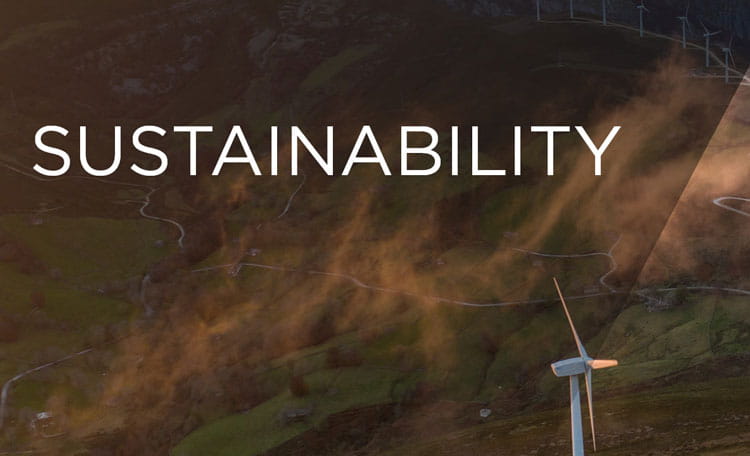
Not long ago, Environmental, Social and Governance (ESG) was dismissed as superfluous and unnecessary when it came to commercial real estate. More recently, it became a “nice to have.” Today, ESG has become a “must have” and is viewed as a huge opportunity as issues such as climate change pose a real risk to the value of assets of almost every company across the globe.
Since ESG takes into consideration a business’ impact on its operating environment in the investment decision making process alongside other financial motivators,1 businesses must “future-proof” their organizations by analyzing, strategizing, and disclosing their ESG impacts, starting today. Otherwise, they will soon find themselves left behind by others that have embraced the need to develop and execute a clear ESG strategy.
The individual elements of ESG
- Environmental (E) includes the impact an organization has on environmental areas such as energy, greenhouse gas emissions, waste, climate change and resource scarcity.
- Social (S) focuses on how the organization impacts the people it employs as well as the communities which it operates in, including labor rights, land acquisition, workplace/ workforce health and wellness, safety, diversity and community impact.
- Governance (G) examines how the organization governs itself including board structure and composition, executive compensation, business ethics and shareholder rights.
Together, these definitions expand beyond traditional measures of ‘sustainability,’ and the ‘triple bottom line,’ with an increased focus on how these factors contribute to socially responsible investing.
WHAT’S DRIVING DEMAND?
ESG investing includes a variety of considerations to satisfy the demands of an extensive list of stakeholders, including commercial real estate (CRE) investors. One in five investors say they decided to not invest with a manager because their ESG policies were inadequate, and as of 2021, 39% of investors are currently invested in ESG products, an increase from 33% in 2020.1 Sustainable investment funds have doubled to $54.6 billion as of the second quarter of 2020.2
There are five key factors driving demand for ESG investment:
- REGULATORY DEMANDS
Currently, 39% of global energy related carbon emissions come from the built environment and approximately 2/3 of the global building area that exists today will still exist in 2040.3 The impact is already being felt at the state and local levels as many regional standards require buildings to reduce their carbon emissions substantially within the next 20-30 years, eventually reaching net zero.
Outside of local regulatory changes, global and national guidelines will come into effect within the next decade—many of which are already here. As of January 2022, the California Senate passed the Climate Corporate Accountability Act (CCAA), the first law in the United States to require large companies to disclose all of their greenhouse gas emissions. This new legislation would require all companies generating more than $1 billion in gross annual revenue to disclose their emissions from all scopes (1, 2, and 3). And the UK will be the first nation in the G20 to force companies to deliver on TCFD (Task Force on Climate-Related Financial Disclosures) reporting requirements.4
As a result of COP26, the IFRS Foundation announced that a new International Sustainability Standards Board (ISSB) has been created to develop a “comprehensive global baseline of high-quality sustainability disclosure standards to meet investors’ information needs.”5
By having a strong ESG strategy, businesses can reduce transitional risk and the potential impacts of regulatory initiatives such as decarbonization efforts and emissions standards. CRE investors can and will be part of the solution by leveraging building intervention points and integrating ESG strategies into their operations.
- THE IMPACT OF MILLENNIALS AND WOMEN
As a new generation begins to represent a larger majority of the investor base, it is essential for organizations to understand what their motivators are—and ESG is near the top of the list. Over the next two to three decades, Millennials are expected to inherit more than $30 trillion6 of generational wealth from the Baby Boomer generation, and by 2025, Millennials will represent three quarters of the global workforce.7
Known as the values-driven generation, a Morgan Stanley study found that Millennials are twice as likely as the general population to invest in companies with social or environmental goals.8
Firms typically lose 70-80% of assets when transferred from one generation to the next.9 In order to retain and attract this growing investor base, organizations need to prioritize how they are addressing ESG within their operations. The Millennial generation—and Millennial women specifically— will be directing their newly inherited capital towards opportunities that not only earn excellent returns, but also contribute to social good and are in alignment with their personal values.
- RISK MITIGATION
For CRE, ESG issues have a quantifiable impact on portfolio risks and opportunities. A recent PwC survey indicates that more than 79% of investors believe that ESG-related risks are an important factor in investment decision-making. Climate change and global sustainability challenges are some of the greatest accelerants facing CRE portfolios. Natural disasters, flood risk, sea-level rise, natural resources scarcity, pollution and health concerns, climate refugees and tropical disease migration present new risk factors for investors. There are two primary risk categories that investors should take into consideration: physical risks and transition risks.
Physical risks include disruptions to operations and supply chains as a result of unplanned changes due to weather and climate. These risks, such as extreme weather events and rising average global temperatures, vary in frequency and severity and are difficult to predict. Global natural disasters resulted in losses of around $5.2 trillion between 1980 and 2018,10 with numbers trending upwards.
Transition risks include business-related risks that follow societal and economic shifts towards a low-carbon and more climate-friendly future.11 Examples include policy and regulatory changes, advancement of technologies, market changes due to supply and demand and the public perception of a company’s operations.
Management of these risk types can reduce cost, frequency of incident management and have a measurable impact on a company’s market value as well as its reputation. Understanding the impact of these issues will allow investors to better reduce the ESG risks associated with operations and create a more resilient business infrastructure.
- POSITIVE BUSINESS OUTCOMES
Sustainability and ESG factors have historically been understood as having little-to-no impact on revenue. Now, investors want to see business strategies tied to long-term value creation, and ESG factors can be used to create best-in-class investment approaches that generate returns in line with or in excess of market.12 Companies with well-managed ESG can see cost reductions, reduce regulatory interventions, and increase employee retention, attraction and productivity. A research study by McKinsey found that ESG can help combat rising operating expenses and impact operating costs by as much as 60%. Much of the built environment can be optimized for enhanced social and environmental benefits, and it is up to the CRE market to act.
At the asset level, value-creation can be found by managing a building’s carbon footprint and integrating ESG risk mitigation processes. This can affect overall net operating income and drive increases in asset value upon disposition. If an owner ultimately wants to sell a property, they will be more likely to attract investors where ESG is a critical qualifier. As research continues to verify the positive correlation between ESG performance, corporate financial performance, and investment returns, organizations should position themselves to exhibit strong performance on ESG-related factors investors believe are linked to value creation.
- SOCIAL STRENGTH
Social impacts of real estate have been historically difficult to measure. Investors are looking to understand how the CRE industry can be leveraged to improve “social good” and have broad impacts beyond the scope of operations. Specifically, at the asset level, it is important to understand how assets engage with and enhance the communities which they operate in—beyond a workplace. Having strong social capital is critical to driving high yield returns, therefore ESG investment strategy must include evaluating how an organization is addressing social impacts. In August 2020, the SEC deemed human capital management as a significant material risk.13
Globally, we are seeing regulations coming up in an attempt to provide a clear measurement of the social factors in ESG. Germany has adopted a supply chain act (GSCA) that sets a new standard for human rights and environmental due diligence. This law will require companies to ensure human rights standards are in place at all tiers of their supply chains.14 The UK now requires employers with a headcount greater than 250 to calculate, report, and publish specific figures related to their gender pay gap.15 Another example includes Australia’s Modern Slavery Act (NWS Act) which establishes mandatory reporting obligations related to the risk of modern slavery in the operations and supply chain of organizations.16
STAYING FOCUSED ON ESG INVESTMENT STRATEGIES IS CRITICAL
As these regulations and measurement methodologies continue to expand, we will see investors continue to take note of which organizations are demonstrating holistic ESG strategies. ESG risks will apply to all businesses and industries, though the relevance of the risks present will vary. Given their exposure and unique position as market influencers, large multi-national asset managers and investment managers will best position themselves in the future by focusing on ESG investment strategies. The global real estate market is experiencing the convergence of ESG, regulatory demands, occupant needs and increased market demands, creating the perfect opportunity to create long-term portfolio value and lasting positive environmental and social impact. If the listed demands are not addressed, we will start to see “stranded assets”— buildings that do not meet those ESG requirements of investors or occupiers.
The good news is that all industries are beginning to realize that ESG concerns are more urgent than ever. Integrating ESG investment strategies into business will prove to establish resiliency, create long-term value, and create a positive and lasting impact on the environment and our society as a whole.
ESG Will Play a Critical Role in Valuations as Well
With the ongoing concern surrounding transmission of the COVID-19 virus, more sustainable office buildings with strong covenants are attracting tenants who are looking for the best air quality possible for their people. This demand enables these buildings to recover faster from both an occupancy and rent growth perspective and the strong covenants also help ensure bond-like cash flows for the building owner.
Conversely, Class B (or lower) buildings are becoming less competitive due to the costs associated with implementing advanced HVAC/filtration systems. And in certain situations, there’s even a risk of material obsolescence—for instance, in the event regulatory requirements for enhanced energy efficiency standards, air quality, or carbon emission requirements aren’t met.
Going forward, once credible benchmarking data on property performance becomes available and a standard set of ESG KPIs are established, sustainability features will play a more significant role in value considerations. Climate change data will also become more of a factor for a range of asset classes and valuers will need to reflect up-to-date information on environmental and physical risks. For example, areas that are more prone to flooding will present greater risks for supply chain disruptions for industrial, as will unplanned outages for data centers, etc.
RESILIENCE IS KEY
Sustainability features will have a much larger impact on global property values in the medium and long term. Currently, our valuation teams around the globe are working with our data teams to see how we can develop a “resilience” index which would score buildings on a number of ESG criteria to help rank the performance of the asset relative to its peer group. We also expect that there will be more third-party data available in the medium term for our teams to factor into our valuations.
Read the full article.



